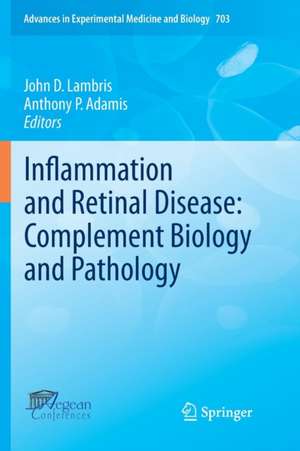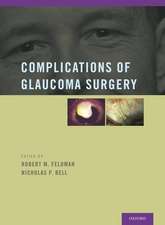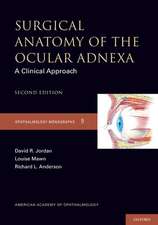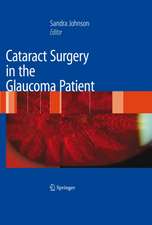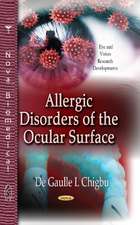Inflammation and Retinal Disease: Complement Biology and Pathology: Advances in Experimental Medicine and Biology, cartea 703
Editat de John D. Lambris, Anthony P. Adamisen Limba Engleză Paperback – 13 oct 2012
| Toate formatele și edițiile | Preț | Express |
|---|---|---|
| Paperback (1) | 1403.68 lei 43-57 zile | |
| Springer – 13 oct 2012 | 1403.68 lei 43-57 zile | |
| Hardback (1) | 1409.69 lei 43-57 zile | |
| Springer – 25 aug 2010 | 1409.69 lei 43-57 zile |
Din seria Advances in Experimental Medicine and Biology
- 9%
 Preț: 719.60 lei
Preț: 719.60 lei - 20%
 Preț: 691.93 lei
Preț: 691.93 lei - 5%
 Preț: 717.00 lei
Preț: 717.00 lei - 5%
 Preț: 716.28 lei
Preț: 716.28 lei - 5%
 Preț: 717.20 lei
Preț: 717.20 lei - 15%
 Preț: 640.24 lei
Preț: 640.24 lei - 5%
 Preț: 1113.83 lei
Preț: 1113.83 lei - 5%
 Preț: 715.71 lei
Preț: 715.71 lei - 5%
 Preț: 820.43 lei
Preț: 820.43 lei - 15%
 Preț: 641.38 lei
Preț: 641.38 lei - 5%
 Preț: 716.28 lei
Preț: 716.28 lei - 5%
 Preț: 523.99 lei
Preț: 523.99 lei - 5%
 Preț: 1031.00 lei
Preț: 1031.00 lei - 5%
 Preț: 717.00 lei
Preț: 717.00 lei - 5%
 Preț: 715.35 lei
Preț: 715.35 lei - 20%
 Preț: 1161.71 lei
Preț: 1161.71 lei - 5%
 Preț: 1170.51 lei
Preț: 1170.51 lei - 18%
 Preț: 1119.87 lei
Preț: 1119.87 lei - 5%
 Preț: 1288.48 lei
Preț: 1288.48 lei - 5%
 Preț: 1164.67 lei
Preț: 1164.67 lei - 5%
 Preț: 1101.73 lei
Preț: 1101.73 lei - 18%
 Preț: 1123.67 lei
Preț: 1123.67 lei - 5%
 Preț: 1435.64 lei
Preț: 1435.64 lei - 20%
 Preț: 1044.10 lei
Preț: 1044.10 lei - 18%
 Preț: 946.39 lei
Preț: 946.39 lei - 5%
 Preț: 292.57 lei
Preț: 292.57 lei - 18%
 Preț: 957.62 lei
Preț: 957.62 lei - 18%
 Preț: 1235.76 lei
Preț: 1235.76 lei - 5%
 Preț: 1231.55 lei
Preț: 1231.55 lei - 5%
 Preț: 1292.30 lei
Preț: 1292.30 lei - 5%
 Preț: 1102.10 lei
Preț: 1102.10 lei - 18%
 Preț: 1132.81 lei
Preț: 1132.81 lei - 5%
 Preț: 1165.19 lei
Preț: 1165.19 lei - 5%
 Preț: 1418.48 lei
Preț: 1418.48 lei - 5%
 Preț: 1305.63 lei
Preț: 1305.63 lei - 18%
 Preț: 1417.72 lei
Preț: 1417.72 lei - 18%
 Preț: 1412.99 lei
Preț: 1412.99 lei - 24%
 Preț: 806.16 lei
Preț: 806.16 lei - 18%
 Preț: 1243.29 lei
Preț: 1243.29 lei - 5%
 Preț: 1429.44 lei
Preț: 1429.44 lei - 5%
 Preț: 1618.70 lei
Preț: 1618.70 lei - 5%
 Preț: 1305.12 lei
Preț: 1305.12 lei - 18%
 Preț: 1124.92 lei
Preț: 1124.92 lei - 5%
 Preț: 1097.54 lei
Preț: 1097.54 lei - 15%
 Preț: 649.87 lei
Preț: 649.87 lei - 5%
 Preț: 1097.54 lei
Preț: 1097.54 lei - 18%
 Preț: 945.79 lei
Preț: 945.79 lei - 5%
 Preț: 1123.16 lei
Preț: 1123.16 lei
Preț: 1403.68 lei
Preț vechi: 1477.56 lei
-5% Nou
268.68€ • 291.94$ • 225.84£
Carte tipărită la comandă
Livrare economică 21 aprilie-05 mai
Specificații
ISBN-10: 1461426480
Pagini: 184
Ilustrații: XIV, 170 p.
Dimensiuni: 155 x 235 x 10 mm
Greutate: 0.27 kg
Ediția:2010
Editura: Springer
Colecția Springer
Seria Advances in Experimental Medicine and Biology
Locul publicării:New York, NY, United States
Public țintă
ResearchCuprins
Textul de pe ultima copertă
Caracteristici
Descriere
Numerous studies have pointed to the key role of complement in the pathogenesis of retinal disease, particularly age-related macular degeneration (AMD). Reports about new gene associations and links to other physiological pathways are emerging almost on a weekly base. Several promising clinical candidates covering a wide area of potential treatment applications are in the pipelines of both industrial and academic groups. This indicates an increasing interest in complement as a therapeutic target. In view of these exciting discoveries, scientists from around the world convened at the First Aegean Conferences Conference on Inflammation and Retinal Disease: Complement Biology and Pathology (June 10–17, 2007) in Crete, Greece, to discuss recent advances in this rapidly-evolving field. This volume represents a collection of topics on the functions of complement in eye diseases, pathophysiology, protein structures, and complement therapeutics discussed during the conference. Our sincere thanks to the contributing authors for the time and effort they have devoted to writing what I consider exceptionally informative chapters in a book that will have a significant impact on the complement field. We would also like to express my thanks to Rodanthi Lambris for her assistance in collating the chapters and preparing the documents for publication and I gratefully acknowledge the generous help provided by Dimitrios Lambris in managing the organization of this meeting. Finally, I also thank Andrea Macaluso of Springer Publishers for her supervision in this book’s production. John D. Lambris Anthony P.
